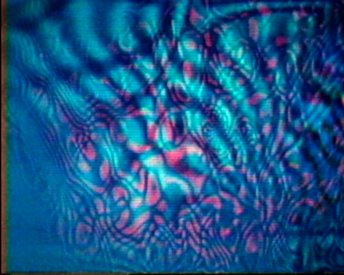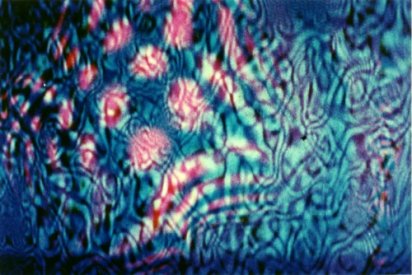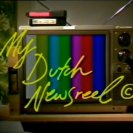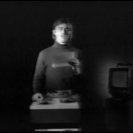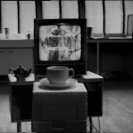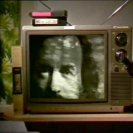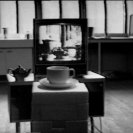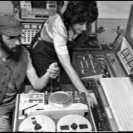David Perry is an Australian experimental film and video-maker, and was a founding member of Ubu Films (1965).1 Previously he trained in the graphics arts (the printing trade) and aspects of graphic arts techniques can be seen in some of his works.
From 1964 he worked for the ABC in their film labs and then in 1968 moved to the Federal Engineering section which was responsible for the tele-recording of all ABC broadcasts. A colleague showed him the effects of a magnet on a damaged camera pick-up tube (image orthicon) and this led to the film Mad Mesh (1968), which is a film recording, with electronic sound track, of the electronic image generated by the distorted grid mesh in the tube.
In 1971 he moved to Great Britain where he took a technical job at the Hornsey College of Art, and he was later asked to teach film and video. Perry had heard of the newly available video portapak, and convinced the college to buy some video equipment and created a live video process installation in a corridor using delayed playback shown against the current live display. This provided his students the experience of the past injected into the present, in which the multiple layers of memory immanent in the video system were exploited as interactive processes.
Perry’s work in video continued to explore this layering of memory as it provided a commentary on the ways present situations influence, and are influenced by, our construction of the past, as in Utopian Memory Banks Present: Fragments from the Past (1973) or in My Dutch Newsreel (1972) which explores a European relationship to the landscape.2
He returned to Australia in 1974, living in Sydney briefly, and then, in 1975, took up a creative arts fellowship at Griffith Artworks at Griffith University in southern Brisbane. The works he made at Griffith Artworks over 1975-76 were personal, reflective works, often video diaries, with interwoven layers of memory and the present.3 The diaries include Near Redland Bay and Down to Sydney and Back to Brisbane (both 1975/76). The most notable is the elegant Interior with Views (1976) representing the perfect moment of a cup of tea in the dappled afternoon sunshine; the work runs for the time it takes for the jug to boil.
Following the residency at Griffith Artworks, in 1977 he took a teaching position at the Darling Downs Institute of Advanced Education in Toowoomba, Qld, where he remained until 1979. He then returned to Sydney, and between 1980 and 1989 he worked for the Royal North Shore Hospital Audio-Visual unit making health and medical films and videos. During this period he also reworked some of his earlier video works.
In the 1990s he returned to film-making; acting as a cinematographer, developing a script for a feature film, making the film The Refracting Glasses (1990-92) a paean to the role of art in the early 2oth century, both in Russia in the years immediately after the 1917 revolution and at the fall of the Soviet Union in 1989; and in Australia, the home of the protagonist.
Perry sums up his work by saying that even while working with videotape he still saw himself as a film-maker, although he knew it was impossible to get good kinescope recordings of the video works. The texture and quality disjunctions of video and film, in these attempts to make films with inappropriate equipment, interested him and was “sometimes very lovely” but he really wanted to make films. In 1976, in an interview with John Tranter he says:
“... most of the work I do is designed to be seen on a television screen. I have a number of reasons for preferring video to film. Some of them are technical. Basically it’s a cheaper medium to work in, and has possibilities for easier replay ... you can show it just about anywhere. It’s also more intimate than film ... You have a little box, in an ordinary room — people can feel comfortable about it ... people don’t feel constrained about talking-back to a television screen ... The system is more intimate and less intimidating [than cinema] ... Television allows you to take what you want from it; what you don’t want you can shout back at or ignore.”4
- 1. See also Mudie, p.97,98 and p.260, National Film Theatre Programme Notes.
- 2. McMurchy, M. and Stott, J., Signs of Independents; 10 years of the CDF, Sydney: Australian Film Commission, 1988.
- 3. Mudie, Peter, UBU Films: Sydney Underground Movies, 1965-1970, Sydney: UNSW Press, 1997.
- 4. Dave Perry: Interview by John Tranter, Aspect: Art and Literature, Vol.2 No.2 1976, pp.44 – 49.
Mad Mesh, (1968, 16mm film, Sydney)
My Dutch Newsreel, (1972 and reworked 1986; 16mm film/videotape; 5 minutes; London.)
The Physical Structure of Television Images, (1972; 16mm film/videotape; 10 minutes; London.)
(Utopian Memory Banks Present) Fragments From The Past, (1973; Videotape; 15 minutes; London.)
Goodbye Richard Nixon, (1974 and 1986; Videotape; 5 minutes; Sydney.)
A TV Show, (1975/76; Super-8/videotape; 60 minutes; Griffith Artworks.)
Down To Sydney And Back To Brisbane, (1975/76; Super-8/videotape; 30 minutes;Griffith Artworks.)
Near Redland Bay, (1975/76; Super-8/videotape; 40 minutes; Griffith Artworks.
Interior With Views, (1976; Videotape; 5 minutes; Griffith Artworks.)
Antigone, (1977; 16mm./videotape; 60 minutes; Toowoomba.)
The "Right to March" Rally, (1978; Videotape; 30 minutes; Toowoomba.)
Love and Work, (1986; 16mm./super-8/videotape; 57 minutes; Sydney)
Letter to Russia, (1987/88; Videotape; 37 minutes; Sydney)
Some Techniques in the Films of Paul Winkler, (1995; Videotape; approximately 9 mins.; Sydney)
Dr Jazz, (1997/98, Digital videotape; 55 mins.; Sydney)
